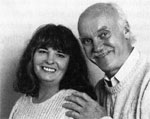COMPASSION IN ACTION: Setting Out on the Path of Service
By Ram Dass & Mirabai Bush.
New York: Bell Tower Books/ Crown Publishing, 1991.
298 pp. $11.00 (paperback).

Ever since Ram Dass met his guru in India in the late sixties, he has been trying to live up to the name his guru gave him: “Servant of God.” Neem Karoli Baba taught Ram Dass that serving God meant learning compassion—he ordered his arrogant ex-Harvard devotee to “serve everyone” and “feed everyone” and “be like Gandhi.”
Here, the author of the pop spiritual classic Be Here Now teams up with Mirabai Bush (also a student of Baba) to serve God and humanity by trying to give inexperienced Westerners a taste of the mighty spiritual potential that dwells in simple acts of love and compassion. Casting out far more heat than light, the effusive Compassion In Action may nonetheless open hearts—the way a chorus of “Amazing Grace” can when sung by a big swaying protest crowd.
Ram Dass’s brief spiritual autobiography, which comprises half the book, focuses on his quest for the state that is hinted at in this classic Buddhist statement: “Out of emptiness arises compassion.” He analyzes the efforts and motivations that have ruled him—from his egocentric, power-craving childhood and haywire Harvard-career days through his current work with the international service organization, the Seva Foundation. At moments, Ram Dass really touches us with his simple honesty. Describing the struggle he went through while tending his dying father, he writes:
At first it was, “Look at me, look what a good son I am.” Then it was, “Doing this is good for me.” Then there was, “Doing it efficiently.” And finally there was, “Just doing it.”
Ram Dass yearns to be able to serve with detachment and unguarded warmth, to open his heart in the midst of heartbreak. Yet Compassion in Action fails to mention the price of emptiness, of opening. He says nothing about the endless hours of meditation and study. Throughout the book, both Ram Dass and Mirabai Bush, who contributed handbook and resource sections, tend to write in a loving, gushing swoon, glossing over difficult subjects as though they are hosting a wonderful party and don’t want anything to spoil the mood.
Bush, for example, fleshes out handbook tips (like starting small and doing what you love) with the stories of people and groups who found personally meaningful ways to help. She describes something called a “Unity Day” in Springfield, Masachusetts, in which people of color used a Native American medicine wheel to illustrate the need for healing. Then she soars on: “We bring everything we have to the situation, and we act—bravely—from the place in ourselves that we trust. We listen and question and look …. “
Ram Dass’s description of flying to the aid of his stepmother captures both the charm and the limitations of the book. In 1985, he entered a Burmese monastery to meditate for three months; after two months, however, a cable arrived informing him that his stepmother was about to undergo surgery for cancer. Ram Dass rushed to the Sayadaw to announce his departure, only to be reminded that he would lose much of the progress that he had gained but not yet stabilized within himself. Ram Dass insisted he had to go.
The Sayadaw looked at him sorrowfully but compassionately, and Ram Dass realized in an instant how caught he was in a web of Western-style commitments and thoughts, “and the sadness of the human condition. And that it was all right, just as it should be.” In its best moments, Compassion in Actiondescribes those gaps between precept and reality that open our hearts because they make us stop and recognize ourselves.
Thank you for subscribing to Tricycle! As a nonprofit, we depend on readers like you to keep Buddhist teachings and practices widely available.